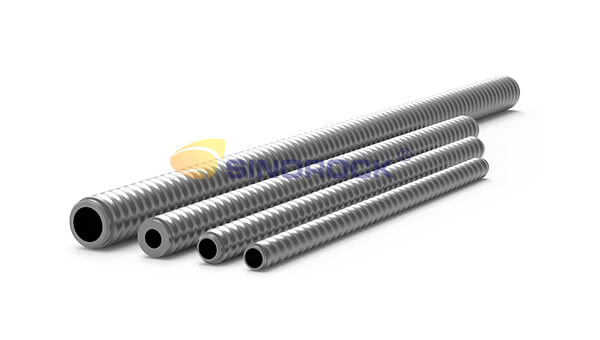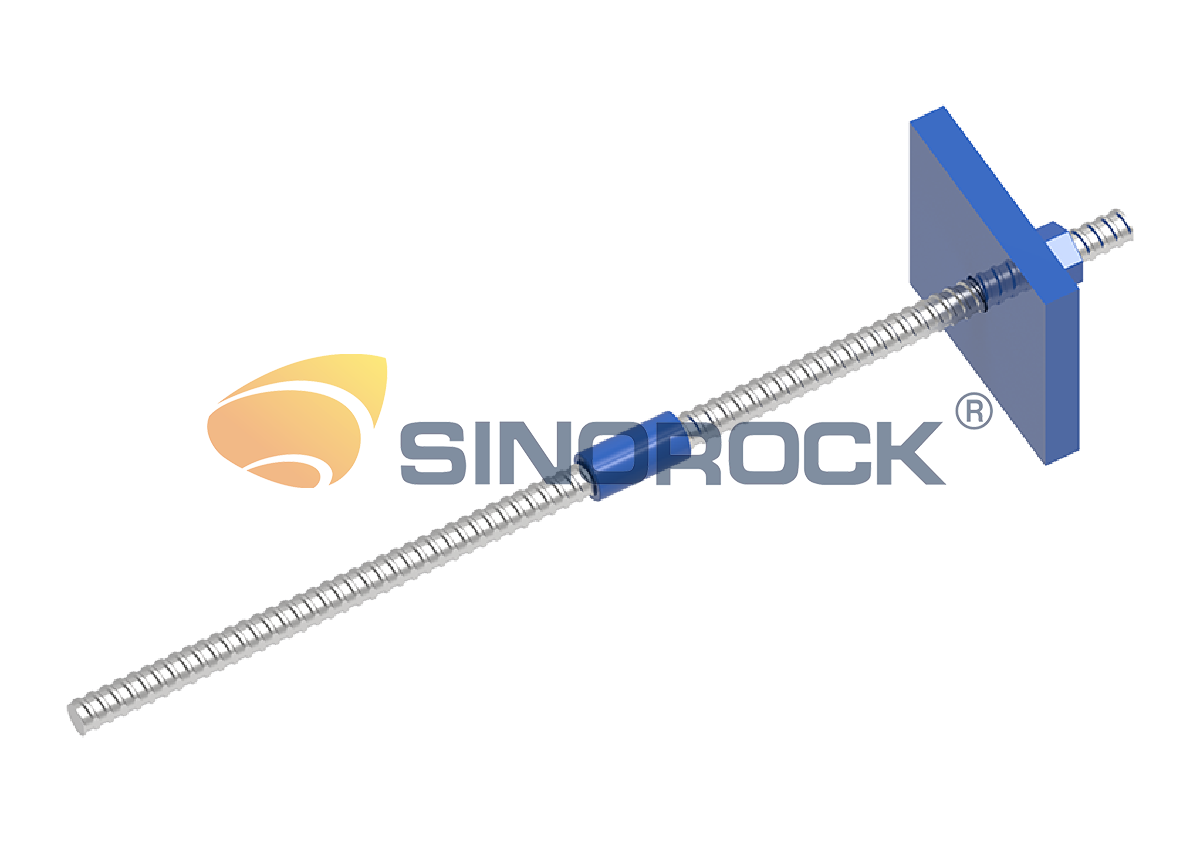Application of hollow bar and solid bar in different formations
Time:2024-03-06From:sinorock View:
Introduction
Hollow bar and solid bar are two different forms of anchoring methods that can be used to meet different geological formations. Unlike other conventional anchoring methods, these anchoring solutions which using rock bars prioritize ground conditions and borehole stability during installation. This article presents these two anchoring solutions, discusses their application in various formations, and illustrates the benefits they offer in specific geologic situations.
Explanation of the Differences Between Hollow and Solid Bars
Hollow Bars
The use of a self-drilling anchor system represents the advancement in anchoring technology. Hollow bars are usually one of the components of self-drilling anchor systems. Characterized by a tubular structure, these bars integrate the functions of drilling and grouting into a seamless process. The hollow core facilitates the evacuation of drill cuttings, ensuring unimpeded progress during drilling. This design eliminates the necessity for additional casings, streamlining the anchoring procedure significantly.

The adaptability of hollow bars is further underscored by a diverse range of drill bits tailored to specific geological conditions. For instance, clay bits are employed for soil, while tungsten carbide button bits prove effective in rock formations. This versatility allows hollow bars to cater to a spectrum of ground compositions, enhancing their applicability across various geological conditions.
Despite these advantages, it is crucial to note that the self-drilling capability of hollow bars might not universally suit all geological conditions. Depending on the specific nature of the formations, considerations for alternative methods may be necessary.
Solid Bars
In contrast, solid bars employ a different drilling method known as Down-The-Hole (DTH), proving particularly efficient in challenging formations, such as tight rock structures. The robust construction of solid threaded steel bars, devoid of a hollow core, imparts durability and strength. This makes them well-suited for scenarios where drilling depths exceed the practical limitations of self-drilling hollow bars.
The DTH drilling method, associated with solid bars, involves drilling first, then followed by an additional grouting step. This method, while not as expedient as self-drilling, becomes indispensable in situations where the drilling depth exceeds the optimal range of self-drilling systems, which provides a reliable and robust solution.

Applications of Hollow Bars in Various Formations and Benefits
1. Loose or Collapsed Formations
In loose or collapsed formations, the self-drilling hollow bar emerges as the optimal solution. Its ability to simultaneously install and grout expedites the process, eliminating the need for additional casing. The self-drilling anchor system proves particularly practical in water-bearing rock formations, where traditional casings may encounter difficulties.2. Variety of Drill Bits
The versatility of hollow anchor bars is further enhanced by a range of drill bits catering to specific geological conditions. From clay bits for soil to tungsten carbide button bits for rock formations, the selection ensures adaptability. However, it's essential to acknowledge that the self-drilling rock bolt might not be universally suitable, depending on the geological nuances.Applications of Solid Bars in Different Formations and Benefits
1. Tight Rock Formations
Solid threaded steel bars, coupled with the DTH drilling method, prove more efficient in tight rock formations. Unlike the disposable drill bits in self-drilling systems, the solid bar offers durability and effectiveness in drilling holes deeper than 5m. The robustness of solid bars makes them the preferred choice in challenging geological conditions.2. Wet Clay Formations
When faced with wet clay formations, challenges arise when using self-drilling anchors. The solid threaded rebar becomes the go-to option in such scenarios, preventing drill cuttings from causing borehole plugging and flushing blockages. Augers are employed for drilling, with solid bars providing the necessary support in wet clay environments.Comparison of Performance and Efficiency of Hollow Bars vs Solid Bars
1. Efficiency in Loose or Collapsed Formations
Hollow bars shine in loose or collapsed formations due to their self-drilling capabilities. The quick installation and simultaneous grouting make them a preferred choice in scenarios where traditional methods may face hindrances.2. Performance in Tight Rock Formations
Solid bars, employing the DTH drilling method, demonstrate superior efficiency in tight rock formations. The durability of solid threaded steel bars ensures effective drilling beyond the limitations of self-drilling systems.3. Adaptability to Wet Clay Formations
While self-drilling hollow bars equipped with nozzles can address wet clay formations, the use of high-pressure flushing requires specialized equipment. In contrast, solid threaded rebar proves more effective in preventing borehole plugging and flushing blockages in wet clay environments.Conclusion
In conclusion, the exploration of hollow and solid bars in anchoring systems reveals a nuanced understanding of their applications and benefits across diverse geological formations. While hollow bars excel in loose or collapsed conditions, solid bars prove indispensable in tight rock formations and wet clay environments. The choice between these anchoring solutions hinges on a thorough evaluation of ground conditions, borehole stability, and the specific challenges posed by each geological formation. As the industry continues to evolve, the versatility and adaptability of hollow and solid bars will undoubtedly play a pivotal role in shaping the future of anchoring technologies.
If you have any needs or questions about hollow and solid bars and their applications, please feel free to contact us at sinorock@sinorockco.com.
latest news
-

- What Are the Applications of SDA Bolts in Hydropower Stations?
- Time:2025-08-21From:This Site
- Learn how self-drilling anchor bolts enhance slope stability, tunnel support, and dam reinforcement in complex geological conditions at hydropower stations. Optimize hydropower projects with efficient, cost-effective, and eco-friendly solutions.
- View details
-

- Slope Stabilization with SDA Bolts: Benefits & Applications
- Time:2025-08-19From:This Site
- Discover how self-drilling anchor bolts (SDA bolts) provide superior slope stabilization for highways, railways, and tunnels. Learn their key benefits, installation process, and real-world applications in loose or collapsible soils.
- View details
-

- How Self-Drilling Rock Bolts Enhance Tunnel Support in Fractured Rock?
- Time:2025-08-15From:This Site
- Discover how self-drilling rock bolts enhance tunnel support in fractured rock. Learn their benefits, installation steps, and real-world applications for safe, efficient tunneling.
- View details
-

- Sinorock 2025 Quality Month | Strengthening Quality Foundations, Empowering Product Excellence
- Time:2025-08-13From:This Site
- Sinorock’s 2025 Quality Month, themed “Strengthening Quality Foundations, Empowering Product Excellence,” successfully concluded, reinforcing our commitment to superior product quality.
- View details
-

- Sinorock Safety Month 2025 | Everyone Speaks Safety, Everyone Can Respond
- Time:2025-07-03From:This Site
- Sinorock Safety Month 2025, centered on the theme "Everyone Speaks Safety, Everyone Can Respond - Spot Workplace Hazards," has wrapped up successfully!
- View details
-

- Quality Control: the Vital Factor of A SDA Bolt Factory
- Time:2025-01-09From:This Site
- Sinorock’s comprehensive quality control system, from supplier management to outgoing inspections, ensuring the highest standards for self-drilling anchor bolts in construction.
- View details
-

- Sinorock Invites You to Explore Proven Self-Drilling Anchor Bolt Solutions at bauma 2025
- Time:2025-03-07From:This Site
- From April 7–13, 2025, explore Sinorock’s Self-drilling anchor bolt solution at Booth C2.513/4 in Hall C2 of the Messe München Exhibition Center (Munich, Germany).
- View details
-
.jpg)
- SINOROCK to Attend EXPOMINA PERÚ 2024 in Lima, Peru
- Time:2024-08-10From:This Site
- Sinorock to Attend EXPOMINA PERÚ 2024 in Lima, Peru
- View details
-
.jpg)
- SINOROCK to Participate in MINING AND METALS CENTRAL ASIA 2024
- Time:2024-08-08From:This Site
- SINOROCK to Participate in MINING AND METALS CENTRAL ASIA 2024
- View details
 Download
Download 


